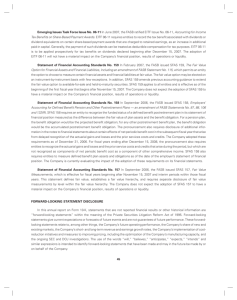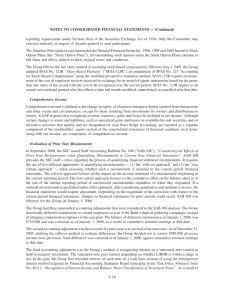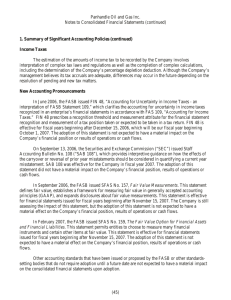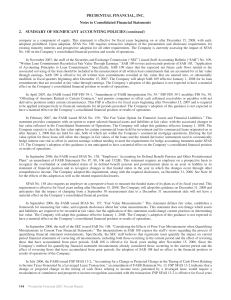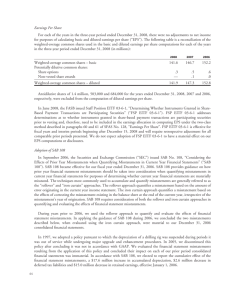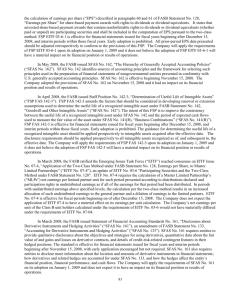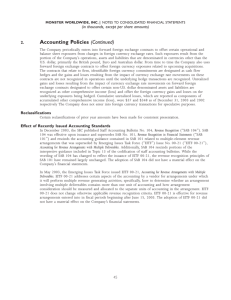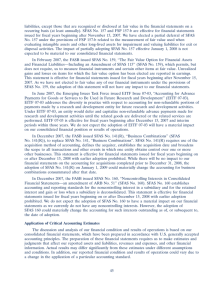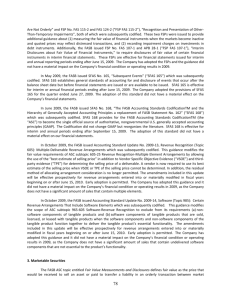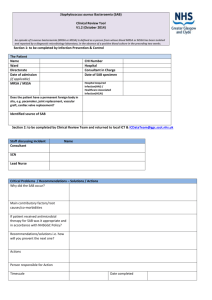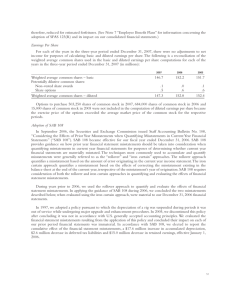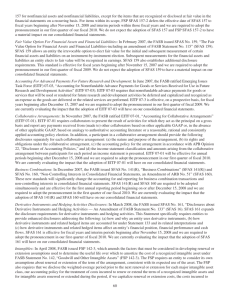At its September 2006 meeting, the EITF reached a final consensus
advertisement
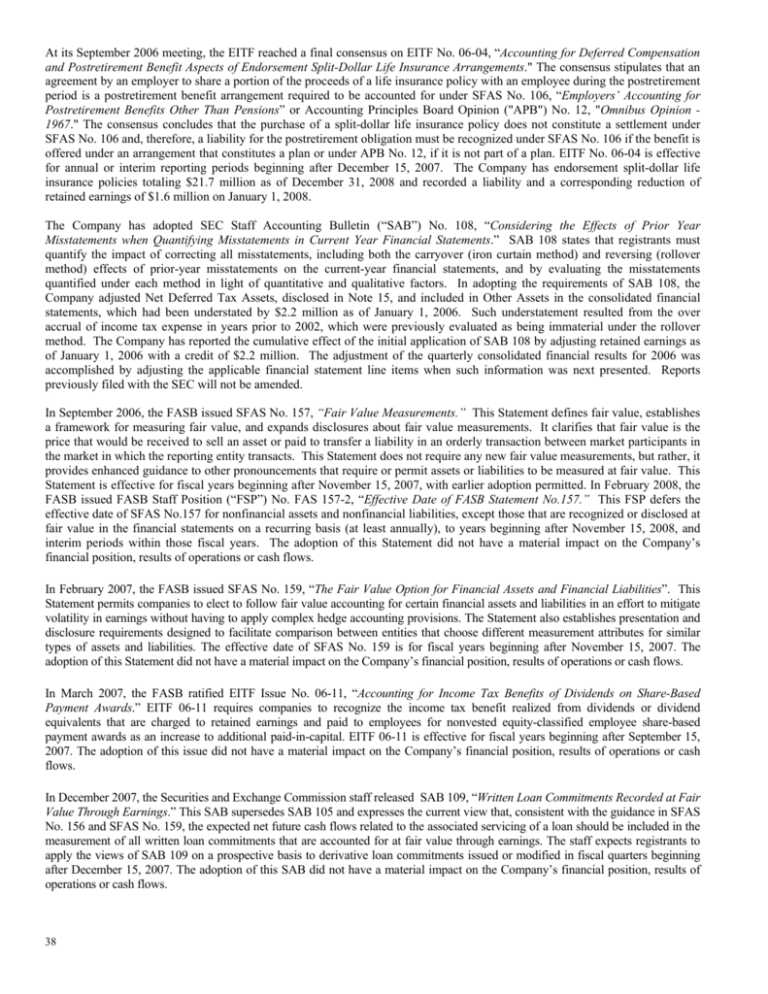
At its September 2006 meeting, the EITF reached a final consensus on EITF No. 06-04, “Accounting for Deferred Compensation and Postretirement Benefit Aspects of Endorsement Split-Dollar Life Insurance Arrangements." The consensus stipulates that an agreement by an employer to share a portion of the proceeds of a life insurance policy with an employee during the postretirement period is a postretirement benefit arrangement required to be accounted for under SFAS No. 106, “Employers’ Accounting for Postretirement Benefits Other Than Pensions” or Accounting Principles Board Opinion ("APB") No. 12, "Omnibus Opinion 1967." The consensus concludes that the purchase of a split-dollar life insurance policy does not constitute a settlement under SFAS No. 106 and, therefore, a liability for the postretirement obligation must be recognized under SFAS No. 106 if the benefit is offered under an arrangement that constitutes a plan or under APB No. 12, if it is not part of a plan. EITF No. 06-04 is effective for annual or interim reporting periods beginning after December 15, 2007. The Company has endorsement split-dollar life insurance policies totaling $21.7 million as of December 31, 2008 and recorded a liability and a corresponding reduction of retained earnings of $1.6 million on January 1, 2008. The Company has adopted SEC Staff Accounting Bulletin (“SAB”) No. 108, “Considering the Effects of Prior Year Misstatements when Quantifying Misstatements in Current Year Financial Statements.” SAB 108 states that registrants must quantify the impact of correcting all misstatements, including both the carryover (iron curtain method) and reversing (rollover method) effects of prior-year misstatements on the current-year financial statements, and by evaluating the misstatements quantified under each method in light of quantitative and qualitative factors. In adopting the requirements of SAB 108, the Company adjusted Net Deferred Tax Assets, disclosed in Note 15, and included in Other Assets in the consolidated financial statements, which had been understated by $2.2 million as of January 1, 2006. Such understatement resulted from the over accrual of income tax expense in years prior to 2002, which were previously evaluated as being immaterial under the rollover method. The Company has reported the cumulative effect of the initial application of SAB 108 by adjusting retained earnings as of January 1, 2006 with a credit of $2.2 million. The adjustment of the quarterly consolidated financial results for 2006 was accomplished by adjusting the applicable financial statement line items when such information was next presented. Reports previously filed with the SEC will not be amended. In September 2006, the FASB issued SFAS No. 157, “Fair Value Measurements.” This Statement defines fair value, establishes a framework for measuring fair value, and expands disclosures about fair value measurements. It clarifies that fair value is the price that would be received to sell an asset or paid to transfer a liability in an orderly transaction between market participants in the market in which the reporting entity transacts. This Statement does not require any new fair value measurements, but rather, it provides enhanced guidance to other pronouncements that require or permit assets or liabilities to be measured at fair value. This Statement is effective for fiscal years beginning after November 15, 2007, with earlier adoption permitted. In February 2008, the FASB issued FASB Staff Position (“FSP”) No. FAS 157-2, “Effective Date of FASB Statement No.157.” This FSP defers the effective date of SFAS No.157 for nonfinancial assets and nonfinancial liabilities, except those that are recognized or disclosed at fair value in the financial statements on a recurring basis (at least annually), to years beginning after November 15, 2008, and interim periods within those fiscal years. The adoption of this Statement did not have a material impact on the Company’s financial position, results of operations or cash flows. In February 2007, the FASB issued SFAS No. 159, “The Fair Value Option for Financial Assets and Financial Liabilities”. This Statement permits companies to elect to follow fair value accounting for certain financial assets and liabilities in an effort to mitigate volatility in earnings without having to apply complex hedge accounting provisions. The Statement also establishes presentation and disclosure requirements designed to facilitate comparison between entities that choose different measurement attributes for similar types of assets and liabilities. The effective date of SFAS No. 159 is for fiscal years beginning after November 15, 2007. The adoption of this Statement did not have a material impact on the Company’s financial position, results of operations or cash flows. In March 2007, the FASB ratified EITF Issue No. 06-11, “Accounting for Income Tax Benefits of Dividends on Share-Based Payment Awards.” EITF 06-11 requires companies to recognize the income tax benefit realized from dividends or dividend equivalents that are charged to retained earnings and paid to employees for nonvested equity-classified employee share-based payment awards as an increase to additional paid-in-capital. EITF 06-11 is effective for fiscal years beginning after September 15, 2007. The adoption of this issue did not have a material impact on the Company’s financial position, results of operations or cash flows. In December 2007, the Securities and Exchange Commission staff released SAB 109, “Written Loan Commitments Recorded at Fair Value Through Earnings.” This SAB supersedes SAB 105 and expresses the current view that, consistent with the guidance in SFAS No. 156 and SFAS No. 159, the expected net future cash flows related to the associated servicing of a loan should be included in the measurement of all written loan commitments that are accounted for at fair value through earnings. The staff expects registrants to apply the views of SAB 109 on a prospective basis to derivative loan commitments issued or modified in fiscal quarters beginning after December 15, 2007. The adoption of this SAB did not have a material impact on the Company’s financial position, results of operations or cash flows. 38
